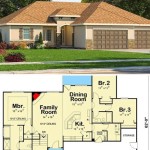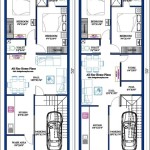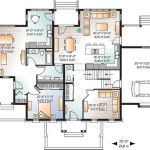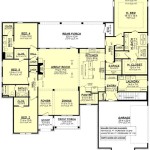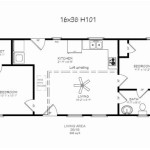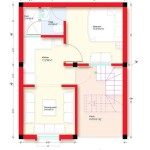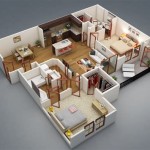3D Rendering of House Plans: A Comprehensive Overview
3D rendering of house plans represents a pivotal shift in architectural visualization and design communication. This technology allows stakeholders, including architects, clients, contractors, and potential buyers, to experience a proposed structure in a realistic and immersive manner before any construction commences. This approach moves beyond traditional 2D blueprints, providing a tangible visual representation that significantly enhances comprehension and decision-making.
The process involves transforming 2D architectural drawings, such as floor plans, elevations, and section views, into three-dimensional models using specialized software. These software programs simulate light, shadows, textures, and materials, creating photorealistic images or interactive virtual tours. The resulting 3D renderings provide a comprehensive understanding of the building's spatial layout, aesthetics, and functionality, facilitating better communication and minimizing costly errors during the construction phase.
The adoption of 3D rendering has revolutionized the architecture, real estate, and construction industries. It offers a distinct advantage over traditional methods by presenting designs in a dynamic and engaging way, fostering collaboration among stakeholders and streamlining the design process. Moreover, 3D renderings provide powerful marketing tools for real estate developers, enabling them to showcase properties to potential buyers even before they are built.
Enhanced Visualization and Design Communication
One of the primary benefits of 3D rendering is its ability to enhance visualization. Traditional 2D blueprints often require a significant level of technical expertise to interpret and understand the spatial relationships within a building. Many clients, particularly those without architectural backgrounds, may struggle to visualize the final outcome accurately based solely on these drawings. 3D renderings, on the other hand, provide a clear and intuitive representation of the design, eliminating ambiguity and facilitating a shared understanding among all stakeholders.
This improved visualization directly translates into more effective design communication. Architects can use 3D renderings to present their designs to clients in a compelling and persuasive manner, showcasing the aesthetic qualities and functional features of the proposed building. Clients, in turn, can provide more informed feedback, identifying potential issues or suggesting modifications before construction begins. This collaborative approach helps to ensure that the final product aligns with the client's vision and requirements.
Furthermore, 3D renderings can be used to explore different design options and scenarios. Architects can easily modify the materials, colors, and finishes in the 3D model to visualize the impact of different design choices. This allows them to experiment with various options and present the client with a range of possibilities, ultimately leading to a more informed and satisfying design outcome. The ability to visualize different design options also helps to mitigate potential risks and identify potential design flaws early in the process, saving time and resources in the long run.
The clarity provided by 3D rendering also aids in securing necessary approvals from planning authorities and regulatory bodies. A well-presented 3D rendering can effectively communicate the design's compliance with building codes and zoning regulations, streamlining the approval process and reducing the likelihood of delays or rejections. The visually appealing nature of these renderings can also help to garner public support for the project, particularly in cases where community involvement is required.
Cost Reduction and Error Minimization
Beyond its aesthetic and communicative benefits, 3D rendering also significantly contributes to cost reduction and error minimization. By providing a comprehensive visual representation of the building design, it allows stakeholders to identify potential problems and make necessary adjustments before construction commences. This proactive approach helps to avoid costly rework and delays that can arise when issues are discovered during the construction phase.
For example, a 3D rendering might reveal a conflict between a structural element and a mechanical system, such as ductwork or plumbing. Identifying this issue early on allows the design team to make the necessary adjustments to avoid costly and time-consuming modifications during construction. Similarly, a 3D rendering can highlight potential accessibility issues, such as doorways that are too narrow or ramps that are too steep, allowing the design to be modified to comply with accessibility standards.
The accurate visualization provided by 3D rendering also facilitates more precise material estimations and cost calculations. By creating a detailed 3D model of the building, architects and contractors can accurately calculate the quantities of materials required for construction. This reduces the risk of over-ordering or under-ordering materials, minimizing waste and saving money. Furthermore, the 3D model can be used to generate detailed cost estimates, allowing clients to make informed decisions about budget allocation and value engineering.
The reduction in errors and rework also translates into improved project timelines. By resolving potential issues during the design phase, 3D rendering helps to prevent costly delays that can arise from unexpected problems during construction. This allows projects to be completed on time and within budget, minimizing financial risks and maximizing returns on investment. The optimized workflow facilitated by 3D rendering contributes to a more efficient and streamlined construction process, benefiting all stakeholders involved in the project.
Marketing and Sales Enhancement in Real Estate
In the real estate industry, 3D rendering serves as a powerful marketing tool, enhancing sales and attracting potential buyers. High-quality 3D renderings can showcase properties in an appealing and realistic manner, even before they are built. This is particularly valuable for pre-construction sales, where buyers rely on visualizations to imagine the finished product. A well-crafted 3D rendering can evoke emotions and create a sense of anticipation, driving interest and generating leads.
3D renderings can be used in various marketing materials, including brochures, websites, and social media campaigns. They can also be incorporated into virtual tours, allowing potential buyers to explore the property remotely and experience the spatial layout and design details firsthand. This immersive experience can be particularly effective in attracting buyers who are located in different geographical areas or who are unable to visit the construction site in person.
The ability to customize 3D renderings to showcase different design options and features is another significant advantage for real estate developers. They can create renderings that highlight different floor plans, finishes, and landscaping options, allowing potential buyers to visualize the property according to their individual preferences. This level of customization can be a powerful selling point, as it allows buyers to imagine themselves living in the property and personalize their experience.
Furthermore, 3D renderings can be used to create photorealistic images of the property in different lighting conditions and seasons. This allows potential buyers to appreciate the aesthetic qualities of the property at different times of day and year, enhancing their understanding and appreciation of the design. The ability to showcase the property in various scenarios can also help to overcome any potential reservations or concerns that buyers may have.
The use of 3D rendering in real estate marketing not only enhances sales but also strengthens brand reputation. By presenting properties in a professional and visually appealing manner, developers can project an image of quality and innovation, attracting discerning buyers and building trust. The investment in high-quality 3D renderings is often seen as a sign of commitment to excellence, which can differentiate developers from their competitors and attract a wider pool of potential buyers.
In conclusion, 3D rendering of house plans has become an indispensable tool in modern architecture, construction, and real estate. Its ability to enhance visualization, reduce costs, and improve marketing efforts makes it a valuable asset for all stakeholders involved in the building process. The technology continues to evolve, with advancements in software and hardware driving even greater levels of realism and interactivity. As 3D rendering becomes increasingly accessible and affordable, its adoption is expected to grow further, transforming the way buildings are designed, constructed, and marketed.

3d Floor Plans Renderings Visualizations Fast Delivery

How Do You Make A 3d Floor Plan

Floor Plan 3d Rendering And House Visualization

3d Floor Plan Skrenders Rendering Company

Floor Plan 3d Rendering Vs 2d Plans What Is Better

3d Floor Plan Skrenders Rendering Company

3d Floor Plan Quality Renderings

What Is A Rendered Floor Plan Cedreo

3d Floor Plan Skrenders Rendering Company

What Is A 3d Floor Plan Rendering Cedreo

